A fashion flashback to the Tokyo 2020 Summer Olympics
The Paris Games are about to begin, and our eyes will be on style.

The excitement is tangible, even though the stands are empty. The only waving flags are in the hands of the athletes marching through the center of the Olympic Stadium. At the Tokyo 2020 Summer Olympics, in-person spectators are limited, but the world is still watching.
Since the first modern Olympic Games held in Athens in 1896, the biennial event has served as an opportunity for countries to define and display their identities on a global scale. The multi-week competition commences with the Opening Ceremony, a spectacle featuring music, dance, cultural rituals and fireworks.
“Every country, especially in the opening ceremony, has the opportunity to express ideas of Olympianism, internationalism, humanitarian values, universalism,” said Jilly Traganaou, a professor of architecture and urbanism at Parsons School of Designs and author of Designing the Olympics.
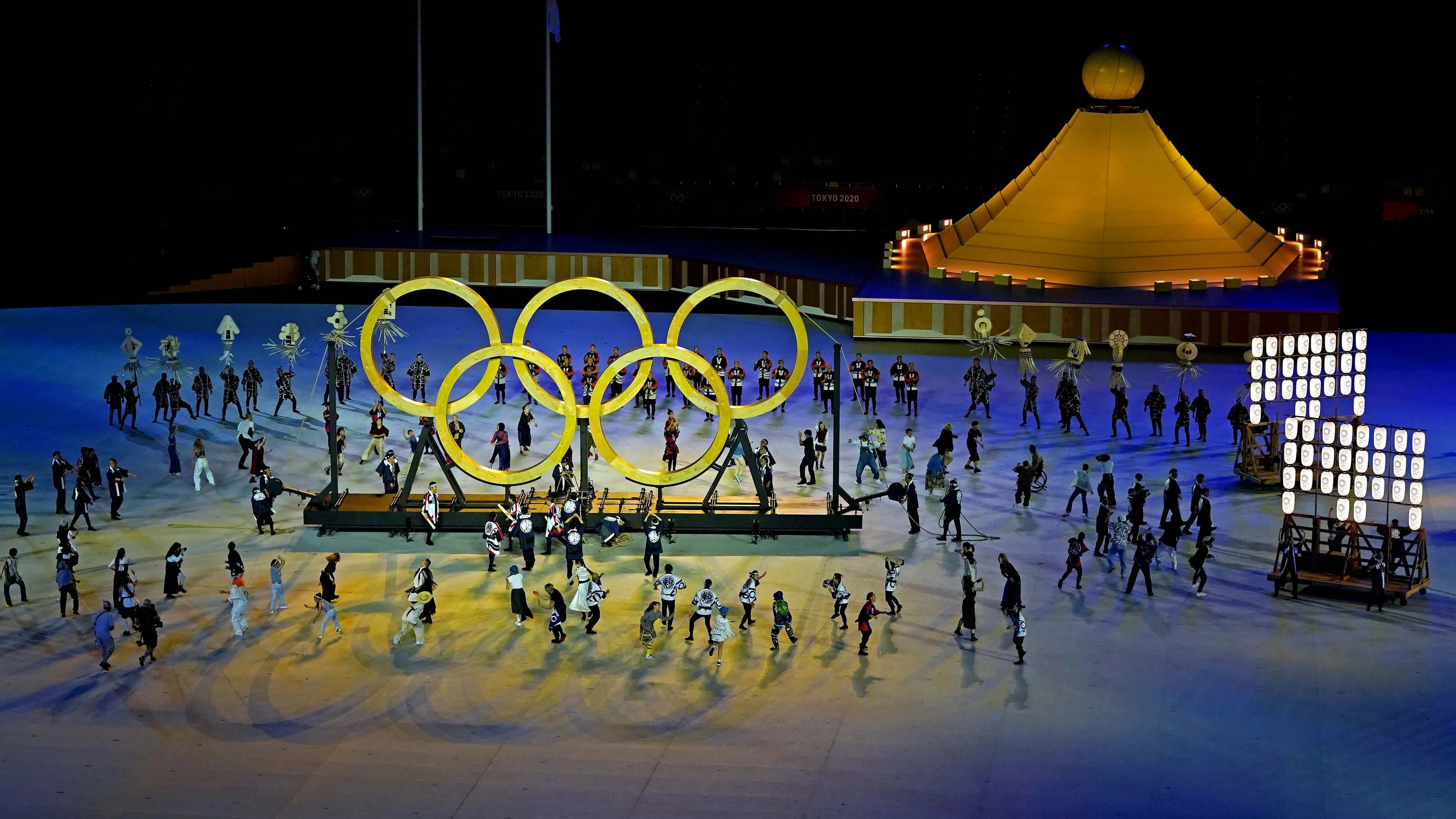
Tokyo 2020 opening ceremony (Sandy Hooper, USA Today)
Tokyo 2020 opening ceremony (Sandy Hooper, USA Today)
The Parade of Nations is a particular highlight of the ceremony. Olympians from each participating country sport custom outfits crafted by a resident designer as emblems of their nation. Before the sport begins, athletes take the stage to showcase style, culture, and art. And for a brief and rare moment during the games, style trumps functionality.
“It’s an exciting moment in the sporting calendar along with the fact that there’s an opening to do something a bit more interesting in terms of clothes,” explained Lauren Cochrane, senior fashion writer at The Guardian.
The Opening Ceremony is also a point of national unity and pride. “Wearing the same outfit as all these other athletes around you from Team USA is so special because it's like you're part of a bigger team, you're part of a bigger everything, and you're representing your country with the best of the best,” said Anita Alvarez, an American synchronized swimmer who competed in the 2016 and 2020 Olympics.
Over the past few years, the intersection of sports and fashion has grown tremendously. In July 2023, Prada became the official sponsor of the China Women’s National Football Team. That October, the Kardashian-owned shapewear brand Skims, which was a Tokyo 2020 Team USA sponsor, became the official underwear partner of the NBA, WNBA and USA Basketball. And in January of this year, Lebron James was the face of a Louis Vuitton campaign.
Players are also leaning into style, turning pre-game arena entrances into runway shows complete with custom looks and photographers. Odell Beckham Jr., an acclaimed wide receiver who currently plays for the Miami Dolphins, made waves with his chic tunnel walks where he modeled designers like Fendi, Off-White and Supreme.
Alvarez pulls inspiration for her competition wear straight from the runway. “I'll see a dress that's worn at the Met Gala or something, and I'm like, ‘yes, I want that as a swimsuit,’” she said, citing Iris van Herpen as a favorite designer of hers.
The upcoming 2024 Paris Olympics are sponsored by LVMH, a French luxury conglomerate that owns a portfolio of high-fashion labels, including Christian Dior, Loewe and Givenchy. At this year’s games, fashion will undoubtedly be the topic du jour. But while we await the release of the remaining Olympic kits, here's a look back at the Opening Ceremony fashion from the Tokyo 2020 Summer Olympics.

We gathered data on the top ten gold-medal-winning countries, with the addition of Canada and Mexico as to include all of North America. Coincidentally, Canada also holds the 11th spot for most gold medals won overall.
Through a visual analysis of videos and images from the Olympics official Opening Ceremony stream, existing articles, brand sites and social media, we curated statistics relating to clothing types, designers, colors, accessories and the use of flags by each examined team. We separated the data by gender as some teams had different outfits for men and women, though the majority did not.
Because we created our own dataset, fact-checking was an integral part of our process. To ensure that our analyses were accurate, especially when working with low-quality videos and images, we essentially repeated our entire collection method twice. We crafted a comprehensive spreadsheet to guide our narrative, and as we wrote, we went back and confirmed the accuracy of every cell.
Who wore what?

Most teams outfitted their Olympians in the same bottoms, tops, outerwear and shoes regardless of gender. Female Olympians for the teams of Australia, China, and Germany all wore dresses. At the same time, Team Netherlands created an additional jumpsuit option for their women – a choice that Evita Griskenas, a Team USA gymnast who competed in the Tokyo Olympics, wishes would become more common practice.
“I feel like they're going a lot more towards the gender neutral kind of outfitting, which is nice, but at the same time I would like some stylistic choices that are feminine for the girls,” she said.

Countries outfitted their Olympians in a wide range of styles, cuts and designs. Seven different types of bottoms were used, making it the most diverse category. Almost all teams wore some sort of fashion sneaker. Even so, Japan offered an additional loafer option, and Great Britain, Germany, Canada, and Mexico all had their athletes in athletic sneakers.
The most one-off options were offered for the outer layers. France had shin-length windbreakers in each of the country’s three national flag colors, Adidas put Germany in bright silver vests, and Italy wore white turtleneck sweaters that created a seamless set with their matching white joggers.
Persistent partnerships
For their Opening Ceremony looks, most countries opted to work with familiar designers. Team Australia and Sportscraft have the longest-running partnership of the top-placed countries, having endured since the 2010 Games.
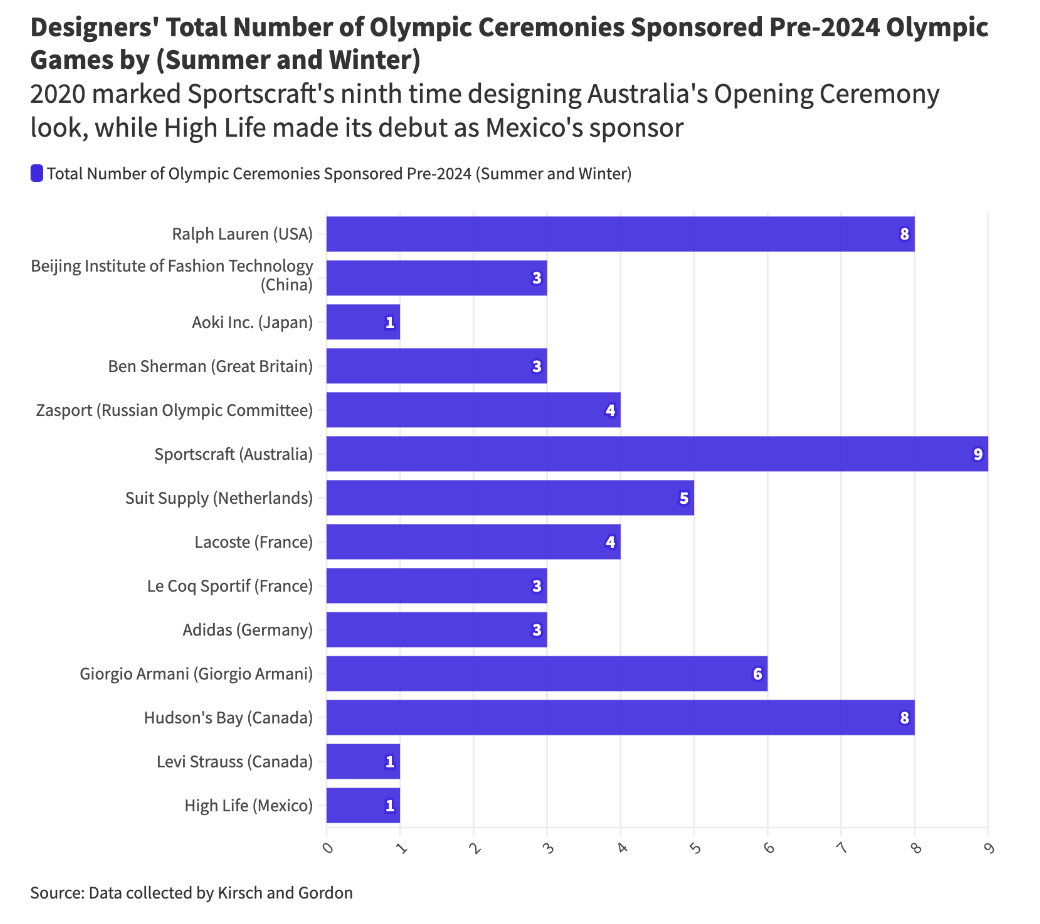
Ralph Lauren has dressed Team USA for the Parade of Nations eight times, sparking mixed reviews about their preppy representation of America.
“I feel like it is a very conservative choice,” said Traganou on hearing that Ralph Lauren is sponsoring the 2024 Games. “This will alienate a lot of people who won't identify and relate to the nation. Definitely immigrants or people of immigrant descent, which of course is a majority in the country.”
But Griskenas didn’t feel that the New York-based brand was playing it safe with their classic blue denim.
“I’d never worn jeans prior to the Olympic ceremony and I've worn them once since,” she said. “They're the only jeans that I still own.”
Alvarez also likes Team USA’s partnership with Ralph Lauren but is open to an outfitter that would allow for more individual styling. “I think what could be cool is to have an outfit that could really fit everyone's different styles, like we're all wearing the same thing but you can change it up a little bit. Because I think that's what makes our country so special too, all of our differences that bring us together, and that kind of freedom to be ourselves.”

Ralph Lauren's Opening Ceremony look featured blue jeans, a blazer and an American flag scarf (Ralph Lauren)
Ralph Lauren's Opening Ceremony look featured blue jeans, a blazer and an American flag scarf (Ralph Lauren)
Though the Olympics are generally more conservative when it comes to style, Cochrane said she would like to see more up-and-coming designers getting the opportunity to outfit the Opening Ceremony.
“There's so many exciting brands in the UK,” she said, noting Saul Nash and Palace. “But, I mean, Ben Sherman’s got great heritage and I don't dispute that. I just feel like they could have pushed the envelope a bit more.”
“People want how their nation is being represented to be not only honorable, but also in a way that they like to be seen by others,” said Traganaou. “People can get upset if they feel the way the country is represented is offensive or far-fetched from how they imagine themselves.”
Two teams, however, experimented with new designers. Mexico partnered with High Life, a luxury menswear brand that produced one of our favorite looks of the event. Japan was sponsored by Aoki, whose chic design caused controversy after it emerged that the brand secured its collaboration through bribery.
Bright and Bold

White was the color used most frequently, appearing at least once in the outfits of every country except Germany; however, it was typically used as a base, making red the most recurrent statement color, appearing 14 times.
Black was barely worn, only appearing in ROC’s and Canada’s shoes and Germany’s mask. Orange was also a rare color at the parade, sported only by the Netherlands through their mask, shirts, and women’s jumpsuits.
The majority of countries utilized the colors of their flags except Australia, the Netherlands, and Germany. Australia opted instead for its national colors of green and gold, which it has used since 1948. The Netherlands did the same with orange, a nod to the country’s royal family, the House of Orange-Nassau.
Out of the countries that did not use the colors of their flags, Germany was the only country that did not use its national colors either. The black, red, and yellow that signify their country were replaced by hues of mint and lime green. While this choice was unconventional, it added to the vibrancy of the parade. Their neon sneakers were perhaps the brightest piece to appear on the Olympic runway.
“I think sometimes for a designer, working with the colors on a flag can be quite limiting,” said Cochrane. “So actually, if you don't see that, it's probably a more interesting proposition.”
France was the only country to divide their design into segments. Overtop a base layer of navy joggers and a white Polo shirt, athletes wore either a white, red or blue windbreaker. Color-blocking the outfits made for an engaging display that mimicked the French flag.
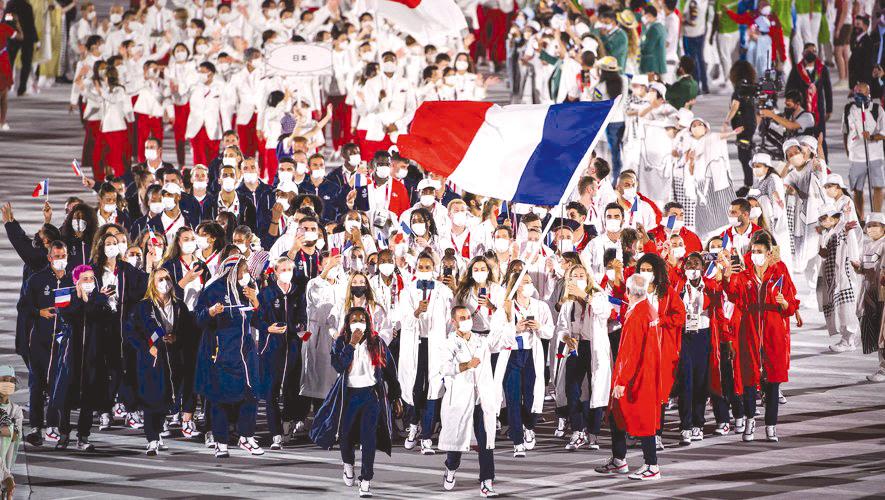
Team France marches in the Parade of Nations (Faxinfo)
Team France marches in the Parade of Nations (Faxinfo)
It’s in the details
Whether you’re a spectator in the arena or a fan watching from home, it can be difficult to make out the intricacies of each outfit. Tokyo was all about the delicate details, from cultural patterns to historical Olympic references.
Team Mexico, designed by High Life, donned navy suits, each embroidered with unique traditional Zapotec designs that were handcrafted by Oaxacan artisans. Female athletes wore colorful flower crowns that matched the embellished lapel. The hues of purple, pink and blue popped against the simple tailored ensemble making for one of the most interesting outfits of the teams we examined.

Each athlete from Team Mexico had a lapel with unique embroidery (High Life Instagram)
Each athlete from Team Mexico had a lapel with unique embroidery (High Life Instagram)
Flowers were also a motif in China’s female outfit design. According to a 2021 article published by China Daily, the pattern on the hem of the dress features the peony, the national flower of China and a symbol of Chinese traditional aesthetics.
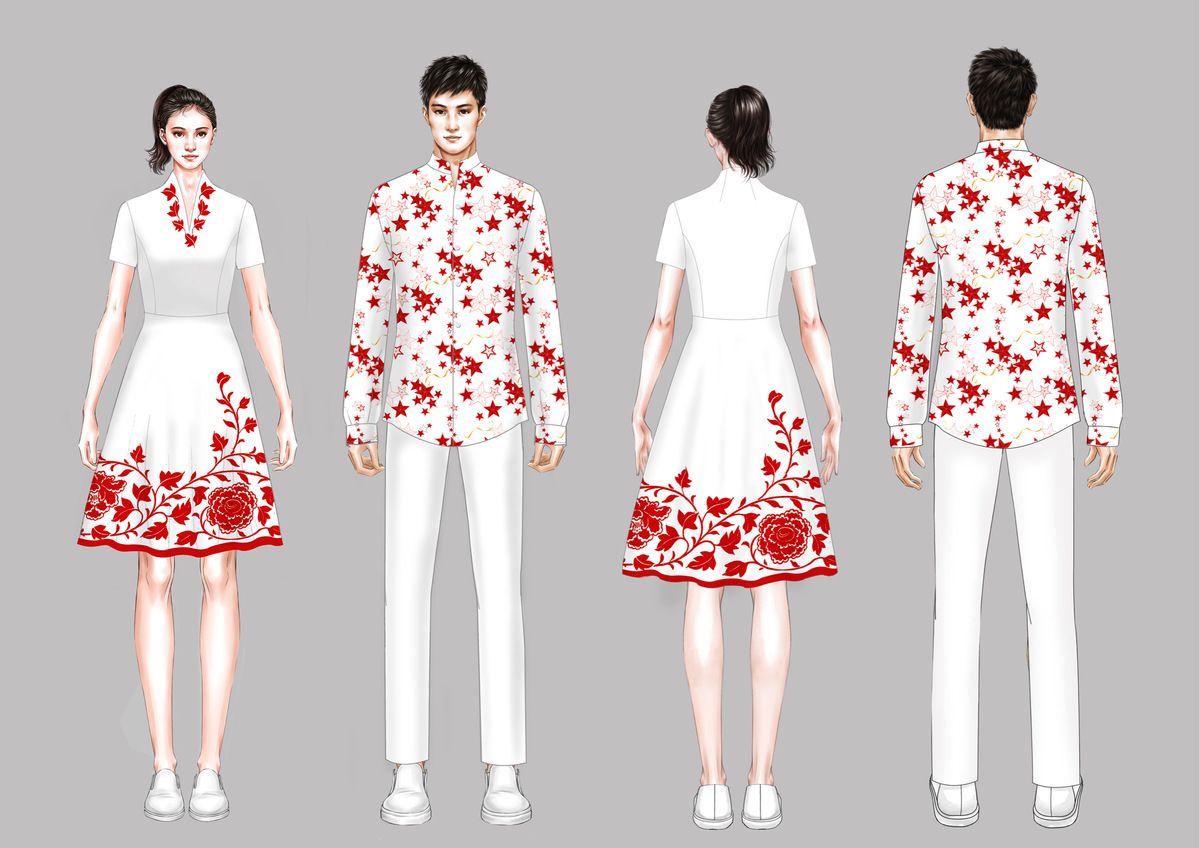
Drawing of China's Opening Ceremony outfits (China Daily)
Drawing of China's Opening Ceremony outfits (China Daily)
Australia’s key detail is invisible to the outside observer but makes a bold statement. The lining of their blazers, designed by Sportscraft, featured the names of all 320 Australian Olympic gold medalists.
“I feel like they’ve got my back – all of us that get a chance to wear this jacket are carrying on the Australian legacy,” Jess Fox, Olympic canoer who has participated in three games, told Vogue.
Another notable element was Team Japan’s decision to dress their Olympic and Paralympic athletes in the same Opening Ceremony uniforms. The host country’s two teams represented Japan’s spirit and dedication toward inclusivity.
The designers also considered Tokyo’s warm summer climate. Germany and Australia’s outfits kept Olympians’ arms and legs exposed to the nighttime breeze. Ralph Lauren got technical, adding a custom pocket near the neck of the Opening Ceremony blazer that's big enough to fit a fan that the Olympian controls via a mini remote—featuring the Polo logo, of course.
Alvarez appreciated the attention to detail. “They're thinking about how it’s going to be a thousand degrees in Japan right now and we're in long blazers and jeans. We're going to be hot, you know? I think that kind of stuff is cool.”
Let your flag fly
A country’s flag is perhaps the simplest form of visual representation. Most teams used their nation’s flag in some form on their outfits, predominantly through color and symbols or by waving a mini flag as they marched in the parade.

Team Canada fronted loose-fitting red track jackets designed by Hudon’s Bay. The jackets featured a large white maple leaf logo on the back. As they stepped into the arena, there was no question which team was making an entrance.

Team Canada's outfits directly reference their flag (Team Canada Instagram)
Team Canada's outfits directly reference their flag (Team Canada Instagram)
Italy’s outfits, crafted by Georgio Armani, were also heavily inspired by the country’s flag. The white sweatshirt base featured a green, red and white circular symbol on its center. Some team members also wore a flag wrapped around their necks like a cape or as a headband. And if that wasn’t enough, their shoes were color-blocked like the Italian flag.

Team Italy sported red, green and white (People)
Team Italy sported red, green and white (People)
While Germany’s outfits did not reference their flag, their masks did. Similarly, while China’s outfit was red and white, their mask was red and yellow, a direct reference to their flag. The Netherlands, however, chose not to display their flag. Their chic orange outfits did not feature red or blue in accompanying accessories, nor did athletes wave mini flags.

Team Netherlands chose to wear their national color and did not march with hand-held flags (People)
Team Netherlands chose to wear their national color and did not march with hand-held flags (People)
Griskenas, who repped Team USA in 2020, appreciated Ralph Lauren’s use of America’s flag as a motif for the outfit.
“I always joke that I'm perpetually ready for the 4th of July because all my outfitting is red, white and blue and we have to rep the colors,” she said. “I mean, after all, we are Team USA.”
Belts and scarves and masks, oh my!
While Olympic clothing deserves fanfare, Opening Ceremony accessories are an equally important way for a country to express its identity. At Tokyo 2020, athletes donned everything from headbands to sunglasses to bags and, of course, masks.

Eight countries wore belts, making it the most seen accessory. Five countries also wore hair accessories, such as Mexico’s floral headbands.
Many Olympians brought personal handbags and purses to the parade, but only Germany sported a team-sponsored crossbody bag. They used it as an opportunity to incorporate its flag colors, and, with the mask, are the only instances where Germany’s flag colors are used.
Although masks were an unexpected addition to the Opening Ceremony, teams integrated them into their designs seamlessly. Some countries, like America and The Netherlands, opted for solid colored masks with a small patch or detailing of their flag and the Olympic rings. For extra emphasis, the Netherlands and Australia emblazoned their country’s names across the front.
Speaking of accessories, on June 18 Ralph Lauren unveiled their Team USA 2024 Opening Ceremony look, which included two belt options. In one promotional photo, surfer Caroline Marks is outfitted in a navy blue belt with an embroidered American flag detail near the silver belt buckle. In another, swimmer Jessica Long is outfitted in a simple brown leather belt with no visible flag symbols.
The look also features a sharp navy blazer — this is the fifth time that Ralph Lauren has outfitted their Olympians in navy blazers — and a pinstripe undershirt. This gave the outfit a slightly more formal look than the last Summer games. Promotional photos show female athletes style their shirts with the first two buttons open and a slightly ruffled collar, while male athletes wear their shirts completely buttoned and add a navy tie with a crisp collar.
The biggest design difference is in the details, with the addition of a red and white stripe lining the lapel, cuffs, pockets and bottom hem of the blazer. Ralph Lauren again made its partnership with Team USA known by embroidering its classic pony logo in white thread onto the navy pocket
Shop the look
Just because you didn’t qualify to compete doesn’t mean you can’t dress like your favorite Olympians. Fans can purchase team kits from some designers, including Ralph Lauren, Lululemon and Ben Sherman.
Team USA
The newly released 2024 Team USA collection is available for purchase on the Ralph Lauren website and on Bloomingdale's online store. The blazer is going for a cool $998 and is already sold out in all but two men's sizes. The jeans are selling for $398.

Swimer Jessica Long models Ralph Lauren’s Paris 2024 Olympic collection (Ralph Lauren)
Swimer Jessica Long models Ralph Lauren’s Paris 2024 Olympic collection (Ralph Lauren)
Fans traveling to Paris for the games will have the opportunity to browse at the official Team USA Shop in the Team USA House, located in the city’s 199-year-old Palais Brongniart in the 2nd arrondissement. Team USA Shop will feature exclusive Team USA and LA28 merchandise from Ralph Lauren, Nike, Oakley, New Era, Mitchell & Ness and Fanatics. You can even buy Team USA and Paris 2024 pins to trade with fans from other countries, just like real Olympians in the village.
Team Canada
Lululemon’s Team Canada collection is already available for purchase on its website and features many of the brand’s classic items emblazoned with the national flag. Fans can choose from red-and-black marbled leggings, fanny packs, t-shirts, puffer jackets, and more items. Prices range from $28 to $448.

Team Canada The Fundamental Graphic Long-Sleeve Shirt COC Logo (Lululemon)
Team Canada The Fundamental Graphic Long-Sleeve Shirt COC Logo (Lululemon)
Fans can snag their Team Canada gear in person at the Lululemon pop-up store located at the Canada Olympic House in La Cité des Sciences et de L’Industrie in Parc de la Villette.
Team Great Britain
Ben Sherman has released a limited number of items from its Olympic collection in the lead-up to Paris 2024. Prices range from $23 for a pair of Opening Ceremony Happy Socks up to $275 for the Team GB Commercial Bomber.
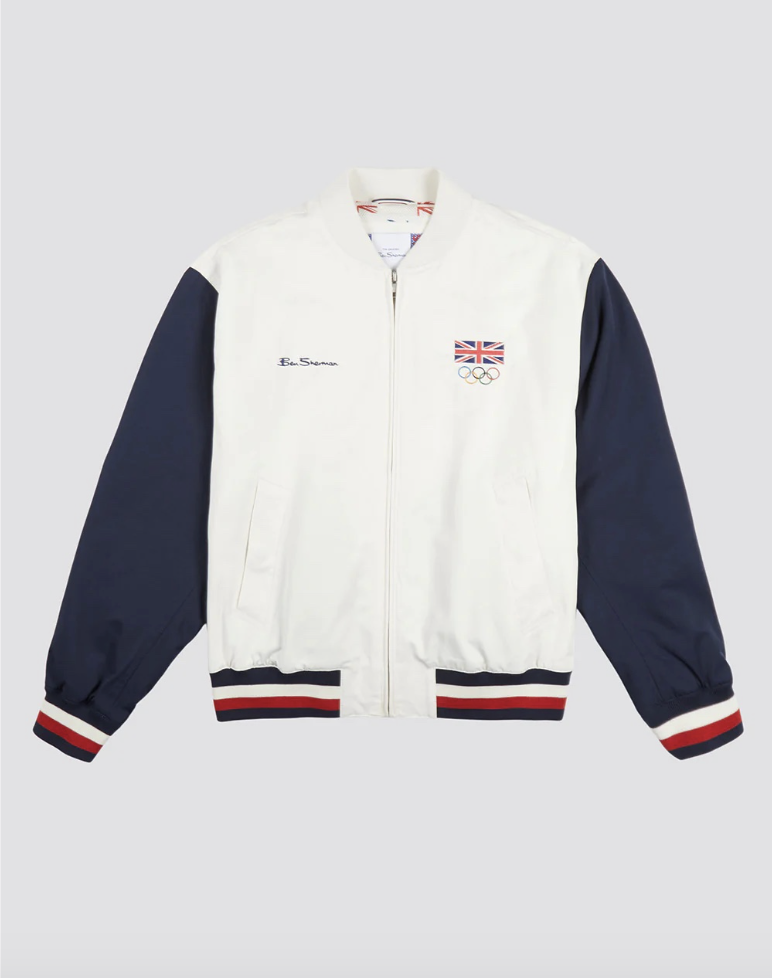
Team GB Commercial Bomber (Ben Sherman)
Team GB Commercial Bomber (Ben Sherman)
Team France
Le Coq Sportif offers a 2024 Team France collection on its website for men, women and kids. T-shirts, shorts, soccer jerseys, hoodies, sweatpants, sneakers and more are available for purchase. Socks sell for 15 euros (16.30 USD) and a zip-up sweatshirt goes for 215 euros (234 USD).

Women's French Team Hoodie (Le Coq Sportif)
Women's French Team Hoodie (Le Coq Sportif)